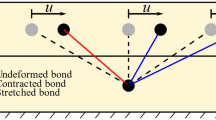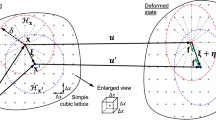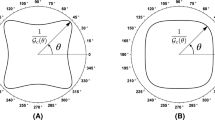Abstract
Peridynamic (PD) theory can overcome the shortcomings of classical continuum mechanics (CCM) in simulating crack initiation and propagation. In this paper, a general anisotropic PD plane model is proposed based on the micro-beam bond. First, the general anisotropic expression of the micromoduli in different directions can be expressed through a certain transformation relation, which can make the bond exhibit general anisotropy. Then, with the use of the Allman interpolation method, the deformations of the bond can be obtained, and the PD strain energy density of the general anisotropic plane model can be expressed. Finally, the general anisotropic PD parameters in the micromoduli expression can be obtained by equating the strain energy densities of PD and CCM models. Numerical examples of static uniaxial tension, static shear, dynamic fracture of the compact tension test and dynamic fracture of the three-hole plate test prove the effectiveness of the proposed model in handling static in-plane problems and dynamic in-plane fracture problems.















Similar content being viewed by others
References
Shi D, Xiao X (2017) A new shell-beam element modeling method and its use in crash simulation of triaxial braided composites. Compos Struct 160:792–803
Murotani K, Yagawa G, Choi JB (2013) Adaptive finite elements using hierarchical mesh and its application to crack propagation analysis. Comput Methods Appl Mech Eng 253:1–14
Schöllmann M, Fulland M, Richard H (2003) Development of a new software for adaptive crack growth simulations in 3D structures. Eng Fract Mech 70(2):249–268
El Khaoulani R, Bouchard P (2012) An anisotropic mesh adaptation strategy for damage and failure in ductile materials. Finite Elem Anal Des 59:1–10
Barenblatt GI (1959) The formation of equilibrium cracks during brittle fracture. General ideas and hypotheses. Axially-symmetric cracks. J Appl Math Mech 23(3):622–636
Belytschko T, Black T (1999) Elastic crack growth in finite elements with minimal remeshing. Int J Numer Methods Eng 45(5):601–620
Klein P, Foulk J, Chen E et al (2001) Physics-based modeling of brittle fracture: cohesive formulations and the application of meshfree methods. Theoret Appl Fract Mech 37(1–3):99–166
Zi G, Rabczuk T, Wall W (2007) Extended meshfree methods without branch enrichment for cohesive cracks. Comput Mech 40(2):367–382
Silling SA (2000) Reformulation of elasticity theory for discontinuities and long-range forces. J Mech Phys Solids 48(1):175–209
Mikata Y (2019) Linear peridynamics for isotropic and anisotropic materials. Int J Solids Struct 158:116–127
Sun S, Sundararaghavan V (2014) A peridynamic implementation of crystal plasticity. Int J Solids Struct 51(19–20):3350–3360
Pashazad H, Kharazi M (2019) A peridynamic plastic model based on von mises criteria with isotropic, kinematic and mixed hardenings under cyclic loading. Int J Mech Sci 156:182–204
Diana V, Ballarini R (2020) Crack kinking in isotropic and orthotropic micropolar peridynamic solids. Int J Solids Struct 196:76–98
D’Antuono P, Morandini M (2017) Thermal shock response via weakly coupled peridynamic thermo-mechanics. Int J Solids Struct 129:74–89
Oterkus S, Madenci E, Agwai A (2014) Fully coupled peridynamic thermomechanics. J Mech Phys Solids 64:1–23
O’Grady J, Foster J (2014) Peridynamic plates and flat shells: a non-ordinary, state-based model. Int J Solids Struct 51(25–26):4572–4579
O’Grady J, Foster J (2014) Peridynamic beams: a non-ordinary, state-based model. Int J Solids Struct 51(18):3177–3183
Zhang Q, Li S, Zhang A-M et al (2022) A nonlocal nonlinear stiffened shell theory with stiffeners modeled as geometrically-exact beams. Comput Methods Appl Mech Eng 397:115150
Kilic B, Agwai A, Madenci E (2009) Peridynamic theory for progressive damage prediction in center-cracked composite laminates. Compos Struct 90(2):141–151
Hu W, Ha YD, Bobaru F (2012) Peridynamic model for dynamic fracture in unidirectional fiber-reinforced composites. Comput Methods Appl Mech Eng 217:247–261
Oterkus E, Madenci E (2012) Peridynamic analysis of fiber-reinforced composite materials. J Mech Mater Struct 7(1):45–84
Ghajari M, Iannucci L, Curtis P (2014) A peridynamic material model for the analysis of dynamic crack propagation in orthotropic media. Comput Methods Appl Mech Eng 276:431–452
Hu Y, Madenci E (2016) Bond-based peridynamic modeling of composite laminates with arbitrary fiber orientation and stacking sequence. Compos Struct 153:139–175
Zhou W, Liu D, Liu N (2017) Analyzing dynamic fracture process in fiber-reinforced composite materials with a peridynamic model. Eng Fract Mech 178:60–76
Hu Y, Yu Y, Wang H (2014) Peridynamic analytical method for progressive damage in notched composite laminates. Compos Struct 108:801–810
Azdoud Y, Han F, Lubineau G (2013) A morphing framework to couple non-local and local anisotropic continua. Int J Solids Struct 50(9):1332–1341
Trageser J, Seleson P (2019) Anisotropic two-dimensional, plane strain, and plane stress models in classical linear elasticity and bond-based peridynamics. arXiv: Classical Physics
Prakash N (2020) A novel numerical method for modeling anisotropy in discretized bond-based peridynamics. CoRR 2011.08013
Diana V, Casolo S (2019) A full orthotropic micropolar peridynamic formulation for linearly elastic solids. Int J Mech Sci 160:140–155
Zhang H, Qiao P (2019) A state-based peridynamic model for quantitative elastic and fracture analysis of orthotropic materials. Eng Fract Mech 206:147–171
Hattori G, Trevelyan J, Coombs WM (2018) A non-ordinary state-based peridynamics framework for anisotropic materials. Comput Methods Appl Mech Eng 339:416–442
Liu S, Fang G, Liang J et al (2020) A new type of peridynamics: element-based peridynamics. Comput Methods Appl Mech Eng 366:113098
Tian DL, Zhou XP (2021) A continuum-kinematics-inspired peridynamic model of anisotropic continua: elasticity, damage, and fracture. Int J Mech Sci 199:106413
Shen G, Xia Y, Hu P et al (2021) Construction of peridynamic beam and shell models on the basis of the micro-beam bond obtained via interpolation method. Eur J Mech A Solids 86:104174
Nguyen-Van H, Mai-Duy N, Tran-Cong T (2009) An improved quadrilateral flat element with drilling degrees of freedom for shell structural analysis. CMES Comput Model Eng Sci 49(2):81–110
Zheng G, Yan Z, Xia Y (2023) Peridynamic shell model based on micro-beam bond. CMES Comput Model Eng Sci 3:1975-1995
Hughes TJ, Brezzi F (1989) On drilling degrees of freedom. Comput Methods Appl Mech Eng 72(1):105–121
Lubineau G, Azdoud Y, Han F et al (2012) A morphing strategy to couple non-local to local continuum mechanics. J Mech Phys Solids 60(6):1088–1102
Zheng G, Li L, Han F et al (2022) Coupled peridynamic model for geometrically nonlinear deformation and fracture analysis of slender beam structures. Int J Numer Methods Eng 123(16):3658–3680
Xia Y, Wang H, Zheng G et al (2022) Discontinuous Galerkin isogeometric analysis with peridynamic model for crack simulation of shell structure. Comput Methods Appl Mech Eng 398:115193
Diana V, Carvelli V (2021) A continuum-molecular model for anisotropic electrically conductive materials. Int J Mech Sci 211:106759
Yu H, Li S (2020) On energy release rates in peridynamics. J Mech Phys Solids 142:104024
Van Buskirk W, Cowin S, Ward RN (1981) Ultrasonic measurement of orthotropic elastic constants of bovine femoral bone. J Biomech Eng 103:67–72
Li J, Li S, Lai X et al (2022) Peridynamic stress is the static first Piola–Kirchhoff Virial stress. Int J Solids Struct 241:111478
Behiri J, Bonfield W (1989) Orientation dependence of the fracture mechanics of cortical bone. J Biomech 22(8–9):863–872
Afshar A, Daneshyar A, Mohammadi S (2015) XFEM analysis of fiber bridging in mixed-mode crack propagation in composites. Compos Struct 125:314–327
Acknowledgements
The authors wish to express their appreciation to the reviewers for their helpful suggestions which greatly improved the presentation of this paper.
Funding
This work was supported by Project of the National Natural Science Foundation of China (Grant No. 12072065) and Applied Basic Research Program of Liaoning Province (Grant Nos. 2022JH2/101300224). These supports are gratefully acknowledged.
Author information
Authors and Affiliations
Corresponding author
Ethics declarations
Conflict of interest
The authors declare that they have no conflicts of interest to report regarding the present study.
Additional information
Publisher's Note
Springer Nature remains neutral with regard to jurisdictional claims in published maps and institutional affiliations.
Rights and permissions
Springer Nature or its licensor (e.g. a society or other partner) holds exclusive rights to this article under a publishing agreement with the author(s) or other rightsholder(s); author self-archiving of the accepted manuscript version of this article is solely governed by the terms of such publishing agreement and applicable law.
About this article
Cite this article
Shen, G., Xu, B., Xia, Y. et al. A general anisotropic peridynamic plane model based on micro-beam bond. Comput Mech 71, 1065–1079 (2023). https://doi.org/10.1007/s00466-023-02274-2
Received:
Accepted:
Published:
Issue Date:
DOI: https://doi.org/10.1007/s00466-023-02274-2




